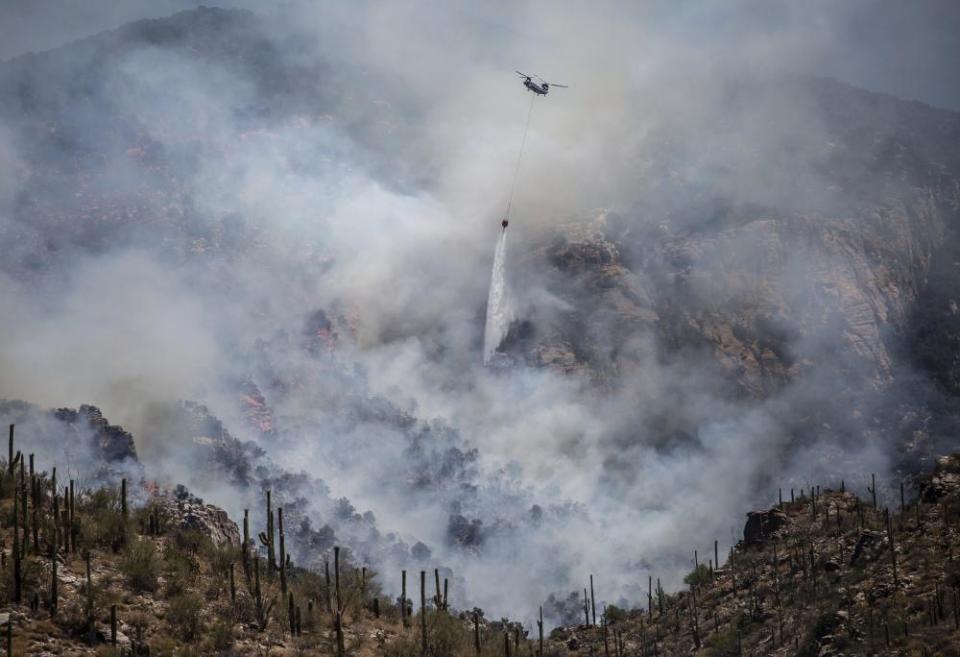Navajo Nation faces twin threats as wildfires spread during pandemic

The Wood Springs 2 fire arrived at Michelle Johnson’s home a week ago. Ash from the 13,000-acre wildfire that burned five miles away rained on her land, with thick smoke billowing above the house she shares with her husband and children.
“It would be like fog,” Johnson said. “You couldn’t open the doors and when I would come outside, I would start coughing.”
Johnson lives in Sawmill, Arizona, a small, rural community on the Navajo Nation in the north-eastern part of the state. The Wood Springs 2 fire is raging about five miles away, and in recent days it appeared to have calmed down, Johnson said. But as it bears down on Navajo communities in Arizona’s north-east, it is exacerbating the region’s already fierce challenges amid Covid-19.
Related: Arizona reels as three of the biggest wildfires in its history ravage state
In Arizona and New Mexico, indigenous people have been dying from coronavirus at disproportionate rates. The Navajo Nation has been ravaged by Covid-19 since the pandemic began.
Indigenous people make up 3.9% of the population in Arizona but account for nearly 20% of Covid-19 deaths, according to the APM Research Lab. Sawmill is located in Arizona’s Apache county, a rural corner of the state that, with just over 71,000 people and more than 2,400 Covid-19 infections, has seen more than three confirmed cases for every 100 people.
“Covid-19 is hitting Sawmill pretty good,” said Wilson Stewart Jr, a Navajo Nation council delegate for Sawmill and other tribal communities in the area. “You have to really watch yourself when you go there.”
Smoke from wildfires could worsen those death rates. Research during the pandemic has linked short- and long-term air pollution exposure with increased chances of Covid-19 complications and death.
Sawmill has not only seen smoke from the Wood Springs 2 fire, but also from a string of larger blazes in southern Arizona that have been burning for weeks. Their smoke blew north-west toward Sawmill and beyond – creating a giant plume that covered much of Colorado and the Four Corners region.
Federal wildfire authorities are warning people who have Covid-19 or are recovering from it near Wood Springs 2 to stay inside.
Bracing for evacuation
Residents are also worried about the rapidly spreading fire potentially forcing them out of their homes.
The Wood Springs 2 fire was first reported on 27 June after lightning struck the dry ground outside Sawmill. An initial report showed the fire at 60 acres. But it grew to over 10,000 acres within a week and crept ever nearer to the town and the nearby community of Fluted Rock.
The fire was 51% contained as of Monday, amid hot and dry conditions that are expected to persist. Fire authorities said on Monday that Sawmill was no longer on “high alert”, but Fluted Rock still was. In addition, the Navajo Nation president, Jonathan Nez, has issued an executive order closing the fire area to the public.
More than 400 fire personnel are working to contain the blaze, but the rapid growth has had people scrambling to make plans in case the situation gets worse.
“We are telling residents of Sawmill and Fluted Rock to be on high alert and to prepare in the event that they need to be evacuated,” said Chantel Herrick, a spokesperson for the local bureau of Indian affairs fire management office, adding that people should check with their local Navajo chapters for details.
Although Sawmill is a year-round residence, people from other towns have summer camps near Fluted Rock where they keep cattle, sheep and horses. Already, four livestock corrals and another building have been destroyed by the fire, according to local fire officials.
Stewart, in his role as a Navajo Nation council delegate, is tasked with figuring out what such an evacuation might look like.
“I did tell the community members: if you need to evacuate,” he said, “your lives are more important than your livestock.”
Johnson and her family keep horses, sheep, chickens and dogs on their property. When the fire began encroaching on their land, they had no plan for getting every person and animal to safety.
“It was scary,” she said. “We didn’t know what to do. It was just me and the kids,” because her husband was at work.
Johnson has since made arrangements to have her uncle help get the family and their animals to safety, if needed. But if things got bad quickly, she said, “we probably would have to pack up what we could and just leave.”
As for the rest of the region’s population, Stewart has been making plans for where they would go. For now, the plan is to send people to facilities in Window Rock, Arizona. People who have tested positive for Covid-19 would go to tents near the hospital there.
Everyone else would go to the school nearby. Stewart said the hospital told him there would be albuterol stocked to treat respiratory issues from the smoke, as well as anxiety medication and counselors. “You can never be too prepared,” he said.
However, gathering scores of people together inside a school building poses a clear Covid-19 transmission risk. Stewart said the plan was to take everyone’s temperature before they entered the school shelter as a precaution.
If an evacuation is ordered, he said, it was tough to say what would happen but he was trying to be responsive to the people he represents.
“With this Covid and this fire now,” Stewart said, “the only thing we can do is pray and help each other.”

 Yahoo News
Yahoo News 